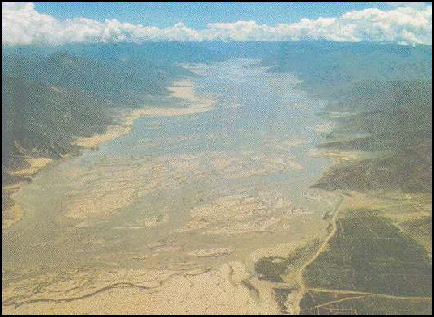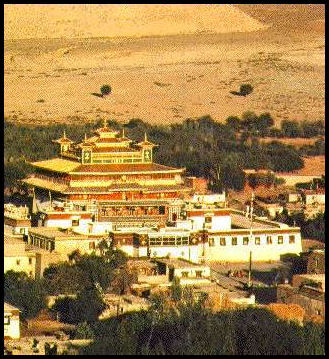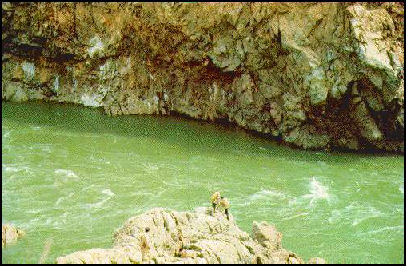SHANNAN PREFECTURE

Shannan Prefecture of is located at the lower reaches of the Yarlung Tsangpo River south of the Kangdese and Nyenchen Tanglha (Nyainqentanglha) Mountains on the Tibetan Plateau. It is bordered by Lhasa Prefecture to the north, Shigatse to the west, Nyingchi to the east, and India and Bhutan to the south. With an area of 73,500 square kilometers, Shannan occupies one-fifteenth of the total area of Tibet. It strategic border with India and Bhutan extends more than 600 kilometers. When the Dalai Lama fled Tibet he did so through the Shannan region. [Source: chinaculture.org, Chinadaily.com.cn, Ministry of Culture, P.R.China]
Shannan includes 12 counties, including four — Cona, Lhongzi, Nanggarze, and Lhoza — which are in border areas. It has a population of more than 350,000 people. There are 144 township-level towns, five neighborhood committees, and 719 village committees. Of the 144 townships, there are 71 agricultural townships, 18 involved in animal husbandry, and 57 that combine these two sectors.
Shannan's topography is typical of the southern Tibetan valley area, with a terrain gradually declining from west to east and at an average elevation of about 3,700 meters. The Yarlung Tsangpo River, the mother river of Tibetan people, runs 424 kilometers from west to east through the seven counties of Nanggarze, Gonggar, Chahang, Nedong, Sangri, Qusum, and Gyacha.
In addition, Shannan has 41 rivers that run down high mountains and deep valleys all year round, with a river area of 38,000 square kilometers. There are 88 lakes in the prefecture, including Yamdrok, Namco, Chigu, and Purmo Yumco, which are well known and, like green gemstones, are inlaid in the mountains of Shannan.
Tuiwa is the second highest village by elevation in the world. It is 5,070 meters (16,663 feet above sea level) The highest village in the world, at 5,130 meters (16,830 feet) is La Rinconada in Peru. Tuiwa in located in Daglung Town, Nagarzê County on the northeast shore of Lake Puma Yumco.[2]
Tradruk Monastery
Tradruk Monastery (east bank of the Yalong River in Shannan, 100 kilometers southeast of Lhasa) was built during the reign of Tubo King Songtsen Gampo in the 7th century and is Tibet's oldest Buddhist worship hall.It is said that Princess Wencheng of the Tang Dynasty (618-907) once lived there when she first entered Tibet. And also, there was once a famous hanging bell made under the supervision of Han monk Master Renqing in the late 8th century, containing 12 sentences of Tibetan epigraphs that were praised by the Tibetan people at that time. [Source: chinaculture.org, Chinadaily.com.cn, Ministry of Culture, P.R.China]
The monastery used to be called Changzhu Monastery In Tibetan, "Chang" means a big roc bird and "Zhu" means dragon. According to a Tibetan legend, the site of the monastery was once occupied by an extremely deep lake. In the lake there is a five-head dragon. After Songtsen Gampo got control of Tibet, he wanted to drain the lake and build a castle there. So he invited two Buddhist masters to lure a big roc bird to attack the dragon. The two masters first imitated the sound of the bird and lured the dragon out; then they imitated the sound of the dragon to lure the bird out. Next, the dragon and the bird began to fight. The bird at last chopped off two of the dragon's heads with its wings. Seven days later, the lake disappeared. That is how the monastery got its name.
Coqen Hall, the main building, enshrines the statues of Songtsen Gampo, Sakyamuni, and Guanyin Bodhisattva, and a winding corridor with many scriptures carved on the wall. The hall on the second floor of the Coqen Hall enshrines the statue of Indian Master Padmasambhava. The Coqen Hall still boasts a lot of statues and mural paintings in the hall. The most attractive is the Pearl-made Tangkha (a kind of embroidery), made of 29,026 pearls, 1 diamond, 1 ruby, 1 sapphire, and 15 grams of gold. It is a miracle to see it have passed down from generation to generation without being damaged or lost during political struggles and wars. Tradruk Monastery has experienced much damage and been repaired many times. During the period of the 5th Dalai, it was repaired with the addition of a golden top. During the reign of the 13th Dalai Lama, it was repaired, enlarged, and renovated again.
Tsetang
Tsetang (200 kilometers southeast of Lhasa) is Tibet's third largest city. Situated on the Yarlung River in the Yarlung Valley, it is the mythical birthplace of the Tibetan people. According to legend a monkey mediating in a cave was seduced by a female demon who refused to wed another monster. She married the monkey and produced six children who grew up to form the six major tribes of Tibet.
Among the sights in Tsetang (also spelled Tsedang, Zedang and Zetang) are monkey caves with stamped characters and the First Field and the First House of the Tibetans. The First Field, north of Tsetang , is where Tibetans have traditionally believed that god bestowed a field for the first cultivated crops. The First House, in Nedong County near Tsetang, was built for the first ruler of Tubo Kingdom. It is a good place to sample Tibetan butter tea and barley wine.
Tsetang is home to around 100,000 people. It is large enough to have a significantly large Chinese population, many of them vendors and construction workers, and its own red light district. Nearby the People's Liberation Army has a large base, guarded by soldiers with bayoneted rifles and fronted by a sign that reads “Maintain National Unity, Safe Guard Territorial Integrity." Web Site: Lonely Planet Lonely Planet and Lonely Planet
Road between Gyangze and Tsetang (beyond Lhasa airport) is spectacular. The route passes through three passes — Gonsidi La, Dunga La, and Shuge La — which range in height from 14,000 feet to nearly 18,000 feet, making this the second highest road in the world. The road also goes near Lake Yamdrok, one of the largest lakes in China. A steep narrow road from Tsetang leads to the ruined palace of Yambu Lhang which, according to legend, was built by the first Tibetan king, Nyatri Tsanpo, and is reputedly the oldest structure in Tibet.
Yarlung River Scenic Area
Yarlung River Scenic Area (accessible from Tsetang, 200 kilometers southeast of Lhasa) covers 920 square kilometers and is the only national key scenic area in Tibet. Located in the river valley at the middle reaches of theYarlung Tsangpo River, this area is regarded as the cradle of Tibetan nationality and features mountains, glaciers, rural scenery, river valleys, alpine plants as well as sacred lakes, historic attractions and folk traditions.
Yarlung River Scenic Area contains 58 scenic spots in 10 large scenic areas from east to west With scenic spots scattered among a 1,580 square kilometer, the scenic area has an average elevation between 3,450 and 3,600 meters. Yagla Xambo Mountain is 6,636 meters (21,771 feet) high. The terrain is high in the south and west and low in the north and east. The turbulent waters of the Yarlung Tsangpo River run through tall mountains and deep valleys. It is spectacular and magnificent and a rarely visited spot. Along both banks the terrain is flat, the climate is pleasant, the soil is fertile and villages are closely linked, each displaying typical south Tibetan rural scenes.
Yarlung River Scenic Area embraces, Yumbu Lhakang, the oldest palace in Tibet, and serves as a burial ground for the kings of the Tubo Kingdom between the 7th and 9th centuries. It also is the home of Tradruk Monastery, the oldest Buddhist temple in Tibet, built in the 7th century. The Samye Monastery, the earliest of its kind in Tibet, sits on the northern bank of the Yarlung Tsangbo River. The legendary monkey cave is half way up the Gongpori Mountain, just behind Tsetang. Among the scenic places are Yamdrok Lake, Gyatsa Lake and Drekhu pasturelands.
Yumbu Lakhang: Tibet’s First Palace and Building
Yumbu Lakhang (192 kilometers southeast of Lhasa, nine kilometers southwest of Tsetang, Lhoka prefecture) is said to be the first palace and the first building in Tibet. Perched atop a small hilltop on the eastern bank of Yarlong River and facing west, it is an ancient structure in the Yarlung Valley. According to legend, it was the palace of the first Tibetan king, Nyatri Tsenpo, who is believed to have descended from the Heaven. . Yumbu Lakhang (Yungbulakang, Yumbu Lakhang) is said to have been built in the 2nd century B.C. by King Nyatri Tsenpo. "Yumbu" means female deer, describing the resemblance of the mountain around the site, and "Lakhang" means holy palace. Yumbu Lakhang means "the palace on back legs of a doe" in the Tibetan language. [Source: chinaculture.org, Chinadaily.com.cn, Ministry of Culture, P.R.China]
Legend says that in the 5th century, a Buddhist sutra fell from the sky onto the roof of Yambu Lakhang. Nobody could read the book. However, a sage predicted it would be interpreted between 7th century to 8th, so the sutra was safeguarded in the palace. Youmpu Lhakang became famous after Songtsan Gambo and Princess Wencheng spent their summer holidays here. It became the summer palace of Songtsen Gampo and Princess Wencheng. These legends really fascinate a lot of people from home and abroad.
Yumpu Lakhang became famous after Songtsan Gambo and Princess Wencheng spent their summer holidays there, making it their summer palace. After Songtsen Gampo transferred his capital to Lhasa in the 7th century, Yumbu Lakhang became a chapel and was converted into a Gulugpa monastery during the reign of the 5th Dalai Lama (17th century).
Yumbu Lakhang consists of three parts: a tower, some chapels, and some monk living quarters. Tibetan kings and their ministers are enshrined in part of the main chapel. Upstairs is a small chanting hall, which houses Sakyamuni and Chenrezi. A mural gallery above tells of Nyatri Tsenpo's arrival from the sky and stories about him as well as Tibetan history.
Samye Monastery: Tibet's First Buddhist Monastery

Samye
Samye Monastery (in Dranang, 30 kilometers west of Tsetang) is the oldest monastery in Tibet. Situated in the Yarlung Valley, it is said to have been built where the Tantric yogi Padmasambhava built an enormous mandala to exorcize evil forces from the area. At the center of the main temple is a large golden Buddha with four corners.
Although the Samye trove has an extensive collection of artifacts, its murals are prestigious throughout Tibet. Samye has many valuable murals. They include murals telling of Padmasambhava's life (ground and second floors of Utse), the history of Samye (south cloister on the second floor of Utse) and other murals reflecting the local folklore. The Samye murals are actually an encyclopedia of Tibetan culture and religion.
Samye means “Unimaginable” in Tibetan. It was said that when King Tritsong Detsen asked for suggestions about the construction of the monastery, Padmasambhava, exerting his magical powers, showed the king an image of a monastery in his palm. That is the origin of the name. Padmasambhava chose the construction site while the design was done by Santarakshita. After the construction was completed, Buddhism became the official religion in Tibet. Learned monks from inland China and India were invited to Tibet to translate Buddhist sutras into Tibetan. Trisong Detsen selected seven nobles to be the first monks in Tibet. Thus, Samye became the first formal monastery to establish triratna (refer to the Buddha), the Dharma and the Sangha, or Buddhist priesthood. [Source: chinaculture.org, Chinadaily.com.cn, Ministry of Culture, P.R.China]
See Separate Article NEAR LHASA factsanddetails.com
Lake Yamdrok
Lake Yamdrok (60 kilometers southwest of Lhasa and 150 kilometers east of Shiagtse) snakes in between mountain slopes and has delightful turquoise color, freezing only a few weeks in the year (usually in February). There are fish in the lake but nobody fishes there due to the Tibetan custom of water burials.
Yamdrok Lake is one of the largest lakes in Tibet and one of the three scared lakes in Tibet along with Manasarovar Lake and Namtso. The largest inland lake near the northern part of the Himalayas, it covers 638 square kilometers. Snow-capped mountains surround the lake, which is fed by many small streams. Within the lake are small green islands that act as resting grounds for groups of wild birds. Buddhist followers believe the water can wash away "five malignancies of the human soul (greed, anger, craziness, sloth and jealousy)" and can remove uncleanliness from human skin. As a result, the holy lake is crowded with people who come to take a bath there every year. These people also carry water from the holy lake on their long journeys back home, and share it with their relatives and friends. [Source: chinaculture.org, Chinadaily.com.cn, Ministry of Culture, P.R.China]
See Separate Article NEAR LHASA factsanddetails.com
Motuo County
Motuo County (South of Nyingchi near Arunachal Pradesh) is said to be the last county in China without a road leading to it. To reach it you have to travel through snow-capped parts of the Himalayas and cross a 200-meter-log suspension bridge.
Motuo ( Mêdog, Metok) County is a county as well as a traditional region of the prefecture-level city of Nyingchi. It further stretches across McMahon Line into neighboring Upper Siang district of Arunachal Pradesh; today one-third of historical Pemako – Lower Pemako – lies in Upper Siang district, which is claimed by the People’s Republic of China.
Motuo means "hidden lotus" in Tibetan. Until 2011 year it was the only county in China with no highway, and is a paradise for travelers and adventurers. Covering an area of 34,000 square kilometers, the mysterious Motuo County is mainly inhabited by the Menba and Luoba ethnic groups, whose population is about 10,000 people. A nine-day trek starts from Paixiang, and passes through Lage, Aniqiao, Badengze and Damu. Travelers should prepare well for the altitude, climate and tough walking conditions. Best time to visit: July to October
Brahmaputra River

Brahmaputra River is one of the world's great rivers and as far as anyone knows no one has ever traveled its entire length. Extending for 3,080 kilometers (1,913 miles) through some of the world's most remote and inhospitable terrain, it begins in the Himalayas in western Tibet as a glacier-fed stream and changes its name and twists and turns through China and India before emptying into Indian Ocean and the Bay of Bengal in Bangladesh. The basin size of the Brahmaputra is 712,035 square kilometers (274,918 square miles). [Source: Jere Van Dyk, National Geographic, November 1988]
By some reckoning the Brahmaputra is the highest river in the world. Brahmaputra means "son of Brahma." Brahma is one of the most prominent Hindu gods. In Hindu cosmology the Brahmaputra is the only male river. The river is regarded as sacred by Buddhists in Tibet but not among the Muslims in Bangladesh.
See Separate Article BRAHMAPUTRA RIVER factsanddetails.com
Image Sources: Wikimedia Commons, Nolls China Web site; CNTO; Perrochon photo site; Beifan.com; University of Washington; Ohio State University; UNESCO; Wikipedia; Julie Chao photo site
Text Sources: CNTO (China National Tourist Organization), China.org, UNESCO, reports submitted to UNESCO, Wikipedia, Lonely Planet guides, New York Times, Washington Post, Los Angeles Times, National Geographic, China Daily, Xinhua, Global Times, The New Yorker, Time, Newsweek, Bloomberg, Reuters, Associated Press, AFP, Compton's Encyclopedia and various books and other publications.
Updated in July 2020
